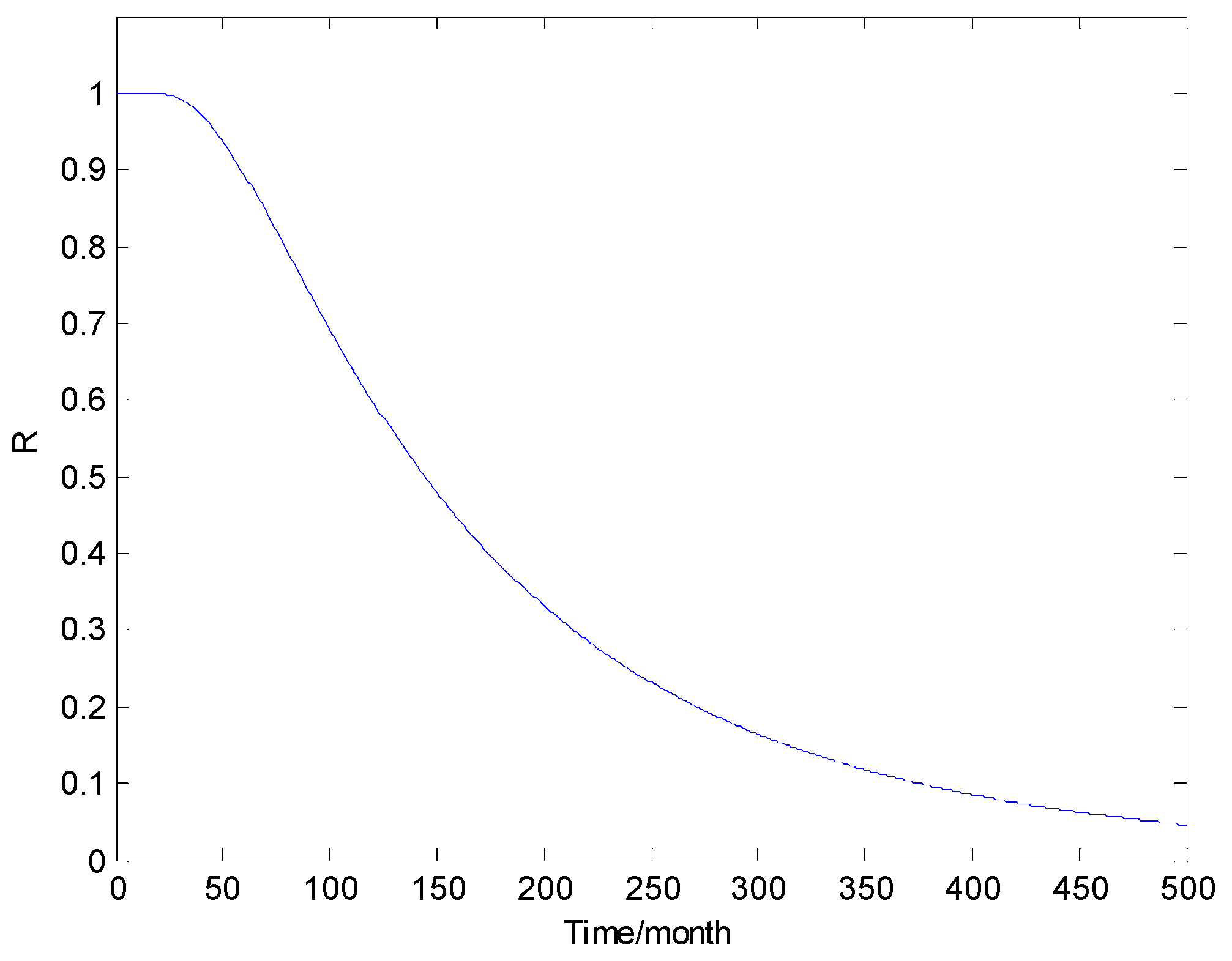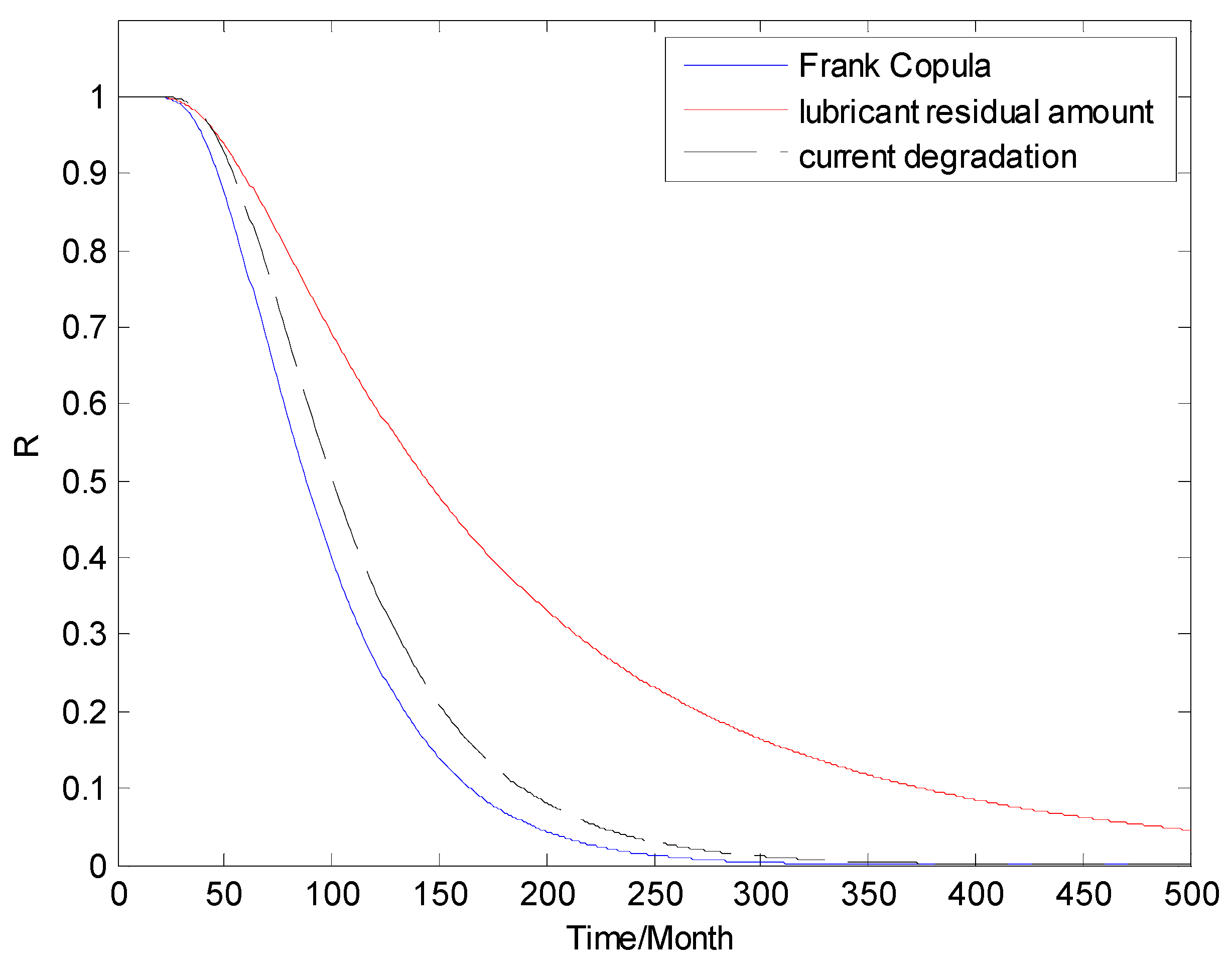Reliability Modeling and Analysis of Multi-Degradation of Momentum Wheel Based on Copula Function
Abstract
:1. Introduction
2. Key Factors Affecting the Life of the Momentum Wheel
3. Establishing a Degenerate Model
3.1. Modeling Ideas
- (1)
- The incremental amount of degradation at any time obeys the normal distribution, that is
- (2)
- The increments in any two disjoint periods are independent of each other. The corresponding mathematical description is as follows: for any , then are independent;
- (3)
- , and is continuous at .
3.2. Failure Distribution
3.3. Parameter Estimation
4. Momentum Wheel Reliability Calculation Based on Copula Function
4.1. Several Copula Functions
4.2. Reliability Calculation Based on Copula Function
- (1)
- The lifetime marginal distribution of the known residual quantity of the lubricant and the lifetime failure margin distribution of the current, let , .
- (2)
- The Copula function contains an unknown parameter , so parameter estimation is needed. Since the margins of lubricant residuals and currents are known, the Canonical maximum likelihood method (CML) is used to estimate the parameters .
- (3)
- Calculate Copula density function and Copula distribution function .
- (4)
- Calculate the momentum wheel residual life probability function based on the Copula distribution function according to the joint probability distribution formula in probability theory.where and are the momentum wheel failure distribution functions based on the remaining quantity of lubricant and the current; and are the corresponding momentum wheel reliability functions; is the Copula joint distribution function.
5. Analysis of Examples
5.1. Reliability Function Based on Lubricant Residual Quantity
5.2. Reliability Function Based on Current Data
5.3. Copula-Based Multi-Degradation Reliability Calculation
6. Conclusions
Author Contributions
Funding
Acknowledgments
Conflicts of Interest
References
- Li, Y.F.; Huang, H.Z.; Mi, J.; Peng, W.; Han, X. Reliability analysis of multi-state systems with common cause failures based on Bayesian network and fuzzy probability. Ann. Oper. Res. 2019, 276, 1–15. [Google Scholar] [CrossRef]
- Li, Y.F.; Liu, Y.; Huang, T.; Huang, H.Z.; Mi, J. Reliability assessment for systems suffering common cause failure based on Bayesian networks and proportional hazards model. Qual. Reliab. Eng. Int. 2020, 36, 2509–2520. [Google Scholar] [CrossRef]
- Mi, J.; Li, Y.F.; Peng, W.; Huang, H.Z. Reliability analysis of complex multi-state system with common cause failure based on evidential networks. Reliab. Eng. Syst. Saf. 2018, 174, 71–81. [Google Scholar] [CrossRef]
- Mi, J.; Beer, M.; Li, Y.F.; Broggi, M.; Cheng, Y. Reliability and importance analysis of uncertain system with common cause failures based on survival signature. Reliab. Eng. Syst. Saf. 2020, 201, 106988. [Google Scholar] [CrossRef]
- Mi, J.; Li, Y.F.; Yang, Y.J.; Peng, W.; Huang, H.Z. Reliability assessment of complex electromechanical systems under epistemic uncertainty. Reliab. Eng. Syst. Saf. 2016, 152, 1–15. [Google Scholar] [CrossRef]
- Mi, J.; Li, Y.F.; Liu, Y.; Yang, Y.J.; Huang, H.Z. Belief universal generating function analysis of multi-state systems under epistemic uncertainty and common cause failures. IEEE Trans. Reliab. 2015, 64, 1300–1309. [Google Scholar] [CrossRef]
- Ramasso, E.; Gouoriveau, R. Remaining useful life estimation by classification of predictions based on a neuro-fuzzy system and theory of belief functions. IEEE Trans. Reliab. 2014, 63, 555–566. [Google Scholar] [CrossRef]
- Qi, H.M.; Cheng, Y.H.; Jiang, B. Remaining lifetime prediction based on multiple fault states for satellite attitude control system. J. Nanjing Univ. Aeronaut. Astronaut. 2015, 47, 29–36. [Google Scholar]
- Kang, G.H.; Xia, Q.; Cheng, J. Design of attitude and orbit control computer of micro satellite based on SoPC. J. Nanjing Univ. Aeronaut. Astronaut. 2013, 45, 763–768. [Google Scholar]
- Jin, G.; Liu, Q.; Zhou, J. RePofe: Reliability physics of failure estimation based on stochastic performance degradation for the momentum wheel. Eng. Fail. Anal. 2012, 22, 50–63. [Google Scholar] [CrossRef]
- Jin, G.; Matthews, D.; Fan, Y. Physics of failure-based degradation modeling and lifetime prediction of the momentum wheel in a dynamic covariate environment. Eng. Fail. Anal. 2013, 28, 222–240. [Google Scholar] [CrossRef]
- Pecht, M.; Gu, J. Physics-of-failure-based prognostics for electronic products. Trans. Inst. Meas. Control. 2009, 31, 309–322. [Google Scholar] [CrossRef]
- Li, H.T.; Jin, G. Momentum wheel wiener process degradation modeling and life prediction. J. Aerosp. Power 2011, 26, 622–628. [Google Scholar]
- Liu, Q.; Zhou, J.L.; Jin, G. Based on random threshold Gauss\rown fure physical model of reliability assessment of momentum wheel. J. Astronaut. 2009, 30, 2109–2115. [Google Scholar]
- Liu, Q. Reliability Modeling and Evaluation Method of Satellite Momentum Wheel’s Performance. Ph.D. Thesis, National University of Defense Technology, Changsha, China, 2006. [Google Scholar]
- Jin, G.; Feng, J. Bayes-Weibull reliability assessment method for long life satellite moving component. Syst. Eng. Electron. 2009, 31, 2020–2083. [Google Scholar]
- McMahon, P.; Laven, R. Results from 10 Years of Reaction/Momentum Wheel Life Testing. In Proceedings of the 11th European Space Mechanisms and Tribology Symposium, Lucerne, Switzerland, 21–23 September 2005; pp. 299–305. [Google Scholar]
- Li, H.T. Reliability Modeling and Analysis of Momentum Wheel Based on Baysian Network. Ph.D. Thesis, National University of Defense Technology, Changsha, China, 2007. [Google Scholar]
- Zhao, Q.; Jia, X.; Cheng, Z.J.; Guo, B. Bayesian estimation of residual life for Weibull-distributed components of on-orbit satellites based on multi-source information fusion. Appl. Sci. 2019, 9, 3017. [Google Scholar] [CrossRef] [Green Version]
- Yu, K. Reliability Estimation for Momentum Wheels Based on Information Fusion. Master’s Thesis, University of Electronic and Science of Technology of China, Chengdu, China, 2019. [Google Scholar]
- Chen, X.F.; Xia, X.T. Dynamic Prediction of Friction Torque Reliability of Super-Precision Rolling Bearings. In Proceedings of the 2020 Prognostics and Health Management Conference (PHM-Besançon), Besançon, France, 4–7 May 2020; pp. 345–348. [Google Scholar]
- Huang, H.Z.; Yu, K.; Huang, T.D.; Li, H.; Qian, H.M. Reliability estimation for momentum wheel bearings considering frictional heat. Eksploat. Niezawodn. Maint. Reliab. 2020, 22, 6–14. [Google Scholar] [CrossRef]
- Mohr, H.D. Real-Time on-Orbit Momentum Wheel Health Monitoring for Robust Satellite Attitude Control. In Proceedings of the 2021 IEEE Aerospace Conference, Now Virtual, 6–13 March 2021; pp. 1–7. [Google Scholar]
- Liu, L.Y. Study on Wear Life of Momentum Wheel Bearing. Ph.D. Thesis, Henan University of Science and Technology, Luoyang, China, 2011. [Google Scholar]
- Liu, W.J.; Liu, C.R. The diagnosed evaluation of momentum wheel failure combination of quantitative and qualitative. Chin. Space Sci. Technol. 2011, 8, 55–63. [Google Scholar]
- Zhang, J.X.; Hu, C.H. Multiple degradation variables modeling for remaining useful life estimation of gyro based on Copula function. Acta Aeronaut. Astonanytica Sin. 2014, 35, 1111–1121. [Google Scholar]
- Cox, D.R.; Miller, H.D. The Theory of Stochastic Processes; Methuen & Co. Ltd.: London, UK, 1965. [Google Scholar]
- Liu, S.N.; Lu, N.Y.; Cheng, Y.H. Residual life prediction method based on multi-degradation quantity of momentum wheel. J. Nanjing Univ. Aeronaut. Astronaut. 2015, 47, 360–366. [Google Scholar]




| Model | Parameter Range | |
|---|---|---|
| Gumble | ||
| Clayton | ||
| Frank |
| No. | Suttle | Initial Weight | The Weight in the First Anatonmic Analysis | The Weight in the Second Anatonmic Analysis |
|---|---|---|---|---|
| 1 | 36.334 | 41.560 | 41.521 | 41.497 |
| 2 | 36.356 | 41.727 | 40.526 | 40.456 |
| 3 | 36.350 | 41.730 | 41.681 | 41.306 |
| 4 | 36.344 | 41.525 | 41.305 | 41.227 |
| 5 | 36.345 | 41.344 | 41.179 | 41.076 |
| Mean | 36.346 | 41.577 | 41.242 | 41.112 |
| Time/Month | 1 | 2 | 3 | 4 | 5 |
|---|---|---|---|---|---|
| 0 | 0.000 | 0.000 | 0.000 | 0.000 | 0.000 |
| 4 | 0.077 | 0.083 | 0.182 | 0.100 | 0.182 |
| 8 | 0.154 | 0.167 | 0.182 | 0.200 | 0.273 |
| 12 | 0.385 | 0.250 | 0.364 | 0.400 | 0.546 |
| 16 | 0.615 | 0.667 | 0.727 | 0.700 | 0.818 |
Publisher’s Note: MDPI stays neutral with regard to jurisdictional claims in published maps and institutional affiliations. |
© 2021 by the authors. Licensee MDPI, Basel, Switzerland. This article is an open access article distributed under the terms and conditions of the Creative Commons Attribution (CC BY) license (https://creativecommons.org/licenses/by/4.0/).
Share and Cite
Li, Y.-F.; Huang, M.; Bai, S.; Chen, Y.; Huang, H.-Z. Reliability Modeling and Analysis of Multi-Degradation of Momentum Wheel Based on Copula Function. Appl. Sci. 2021, 11, 11563. https://doi.org/10.3390/app112311563
Li Y-F, Huang M, Bai S, Chen Y, Huang H-Z. Reliability Modeling and Analysis of Multi-Degradation of Momentum Wheel Based on Copula Function. Applied Sciences. 2021; 11(23):11563. https://doi.org/10.3390/app112311563
Chicago/Turabian StyleLi, Yan-Feng, Ming Huang, Song Bai, Yuan Chen, and Hong-Zhong Huang. 2021. "Reliability Modeling and Analysis of Multi-Degradation of Momentum Wheel Based on Copula Function" Applied Sciences 11, no. 23: 11563. https://doi.org/10.3390/app112311563
APA StyleLi, Y.-F., Huang, M., Bai, S., Chen, Y., & Huang, H.-Z. (2021). Reliability Modeling and Analysis of Multi-Degradation of Momentum Wheel Based on Copula Function. Applied Sciences, 11(23), 11563. https://doi.org/10.3390/app112311563








